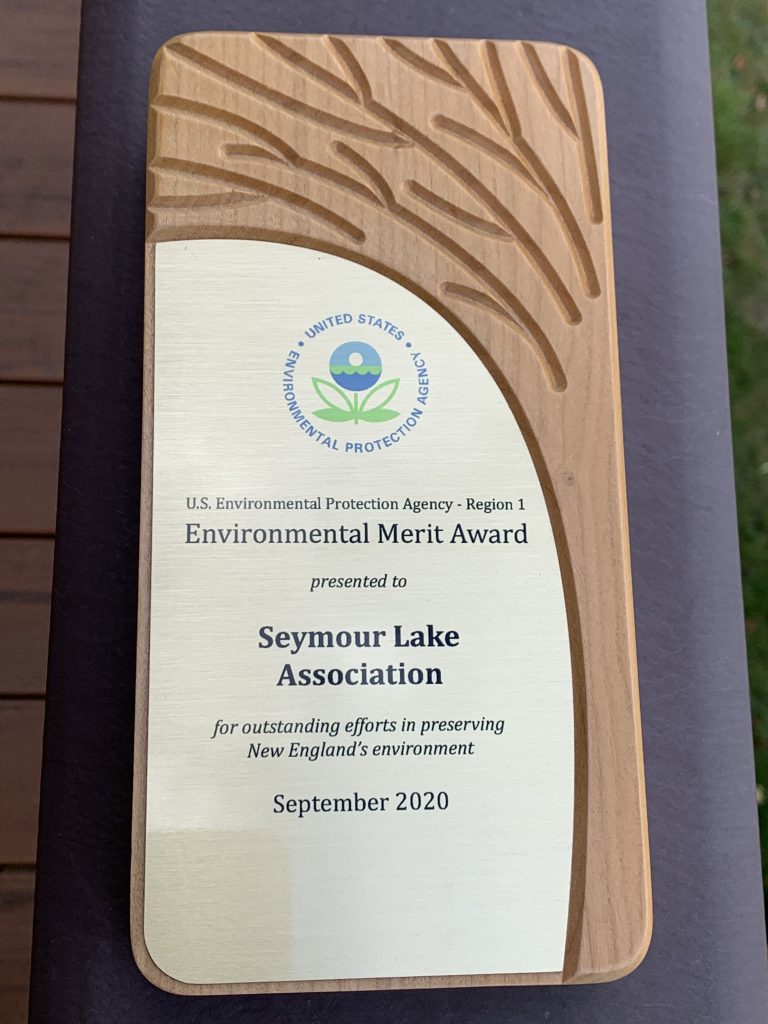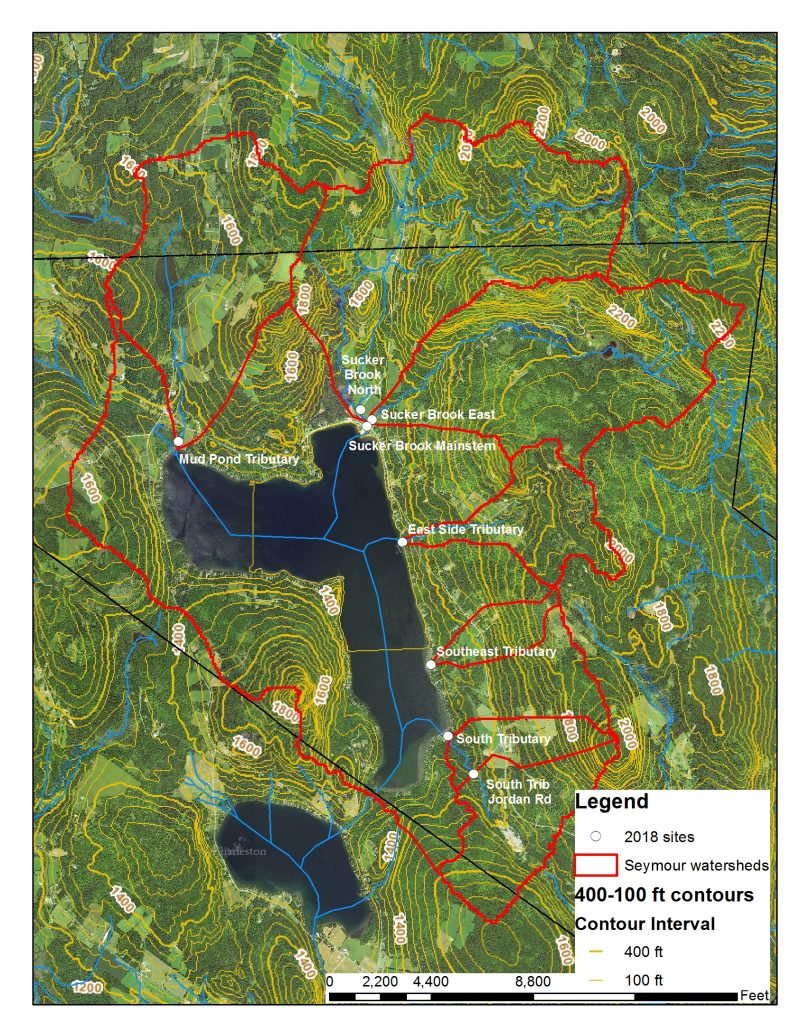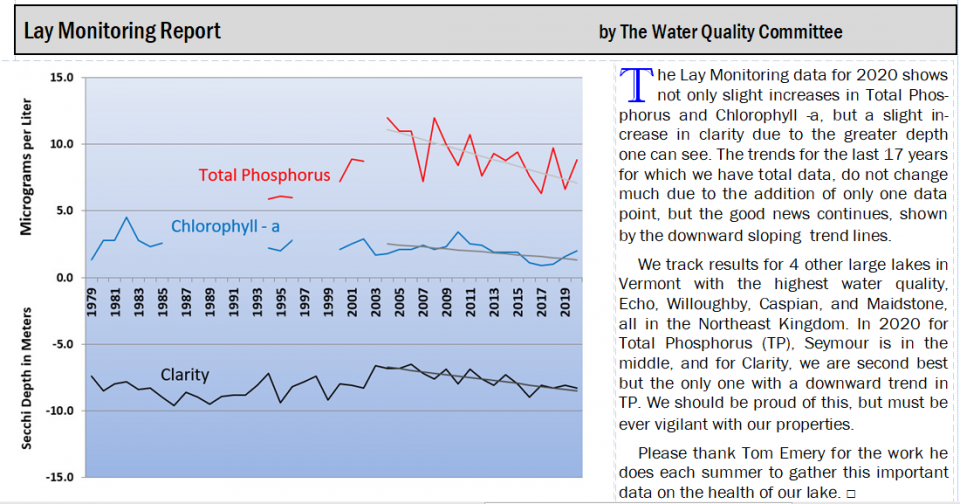Water Quality Successes
EPA Award
On September 15, 2020, Seymour Lake Association was honored to be presented with the prestigious EPA (Environmental Protection Agency) Environmental Merit Award for which we had been nominated by Oliver Pierson, Lakes and Ponds Manager for Vermont’s Department of Environmental Conservation. SLA was selected as one of only three recipients in New England in the Environmental, Community, Academia and Nonprofit category!

Phosphorus Reduction
SLA’s nomination was based on the fact that our lake community, working
together, has diminished the level of phosphorus in the lake. Seymour Lake
is the only lake in Vermont with good water quality which has reversed an increasing phosphorus trend. Also receiving praise in the EPA’s Award Summary is the fact that Seymour Lake has no aquatic invasive species due to our robust boat greeter and education programs. Seymour Lake is again considered a lake with the highest water quality, an achievement due to work of lakeshore owners, farmers, stream bank owners, and all our partners in the watershed.
We had noticed in 2004 that the phosphorus levels were at a higher level than normal, which was very concerning because high phosphorus levels lead to poisonous cyanobacteria (aka blue green algae) blooms. Phosphorus levels increase when natural lakeshore vegetation is disturbed, runoff from local roads is not properly diverted into vegetation, stream banks erode because of removal of natural vegetation and runoff in the uplands increases due to disturbed natural vegetation. Many land owners, especially lakeshore owners pitched in to make changes in their land management. The Town of Morgan as well as lakeshore road owners applied for grants (Better Back Roads) to conduct road management practices which reduced runoff into the lake.
Gold Lake Wise Award
Some lakeshore owners through programs such as the Vermont Lake Wise, have established no-mow zones to replace lawn. Seymour Lake is among the cleanest in Vermont. In addition, Vermont Governor Phil Scott, at the SLA Summer Social in 2019 presented Seymour Lake a “Gold Lake Wise” award in appreciation for the number of properties around Seymour Lake that had received the Lake Wise award.

Water Quality is the condition of the lake’s water which depends upon several factors, but, put simply, it includes very low levels of pollutants such as phosphorus and sediment and the absence of aquatic invasive species such as Eurasian milfoil and zebra mussels.
Learn More
Vermont Lake Wise Program (click here)
Watershed
Water quality is all about the condition of both the lake and the condition of wildlife, streams, soils and plants in its watershed. The condition of the lakeshore is a main contributor to maintaining pristine water quality, but land management throughout the lake’s watershed also affects water quality. The watershed is all the land which drains into a body of water, for Seymour Lake this includes most of Morgan as well as parts of Holland and Charleston. All who live and recreate in Seymour Lake’s Watershed have responsibility to act to protect water quality.
Below is a map showing the land making up Seymour Lake’s Watershed. The map is from Vermont Department of Environmental Conservation. The red lines delineate the flows of the various watersheds within the Seymour Lake Watershed.

The above diagram from Vermont’s Department of Environmental Conservation’s (VDEC) website illustrates how precipitation supplies the water in a lake. Some rain and melted snow soaks into the ground and some evaporates back into the air, but the rest runs downhill into streams and ultimately into lakes or the ocean.
Water Quality and Shoreland Protection
Lake Health Begins at the Shoreline
Healthy lakes begin with healthy shores and the highly sensitive area called the littoral zone, a near shore area where aquatic plants and benthic invertebrates serve as the first link in the food chain. It also serves as a habitat and transition zone between the terrestrial and aquatic zones. Where shoreline has been disturbed through development, physical, biological and chemical parameters are altered and adversely affect the lake.
Learn more
Video depiction of what a littoral zone is (click here)
Read a 2009 study published in Lakeline, “Examining Shorelines, Littorally”, that uncovered the importance of keeping shorelines natural. https://anrweb.vt.gov/PubDocs/DEC/WSMD/Lakes/Docs/lp_littorally.pdf
How is Water Quality Measured?
The Vermont Lay Monitoring Program is the volunteer statewide, lake monitoring program that has sampled more than 80 inland lakes and 30 stations on Lake Champlain since 1979. Measuring the water quality of Seymour, like other lakes in Vermont, is an important scientific endeavor because without data, we cannot really know the status of our water. It is also important to do this over time so that trends can be understood and action taken as a result.
Seymour Lake has participated in this program since its beginning in 1979 Seymour has had many lay monitors over the years and we have been lucky to have most recently, Tom Emery. Tom measures water clarity using a Secchi disk as seen below. Using scientific protocols, he collects water samples which he delivers to Vermont DEC’s laboratories to be tested for phosphorus and chlorophyll.
Learn More
View lay monitoring data for VT lakes here: https://anrweb.vermont.gov/dec/_dec/LayMonitoring.aspx
The Vermont Inland Lake Score Card, launched in 2010, represents 823 VT lakes and scores a lake’s nutrient trend, shoreline and lake habitat, mercury pollution and invasive species. It answers the question, “How is my lake doing?” The score card uses a secchi disk to represent this data. See image for Seymour Lake scorecard as of 2020.
Learn More
- The Lake Score Card https://dec.vermont.gov/watershed/lakes-ponds/data-maps/scorecard
- How lakes are scored https://dec.vermont.gov/sites/dec/files/wsm/lakes/docs/2017%20How%20Lakes%20are%20Scored_final%20Apr%2012.pdf
- View a recorded webinar from VTDEC Watershed Management Division that explains the Lake Score Card https://youtu.be/iNkhA0v9aZA
The Vermont Shoreland Protection Act
Effective July 1, 2014, the Vermont Legislature passed the Shoreland Protection Act (Chapter 49A of Title 10, §1441 et seq.), which regulates shoreland development within 250 feet of a lake’s mean water level for all lakes greater than 10 acres in size. The intent of the Act is to prevent degradation of water quality in lakes, preserve habitat and natural stability of shorelines, and maintain the economic benefits of lakes and their shorelands. The Act seeks to balance good shoreland management and shoreland development.
Any new development, redevelopment, or clearing within 250 feet from mean water level may require a permit or registration. A helpful summary of the Shoreland Protection Act describes the types of activities that are jurisdictional to the Shoreland Protection Act and the standards of the Act. If a shoreland owner proposes a jurisdictional activity, such as tree removal or an expansion of an existing structure, and the standards of the Act cannot be met, the shoreland owner will be required to implement best management practices.
Learn More
The VT Shoreland Protection Act https://dec.vermont.gov/sites/dec/files/wsm/lakes/docs/Shoreland/lp_ShorelandHandbook.pdf

